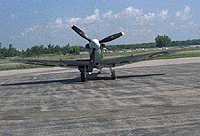Supermarine Spitfire Mk. IIb


- Period: Second World War (1939-1945)
- Uses: Fighter
- First Flight: March 6, 1936 (prototype)
- Display Status: On loan to the Canadian War Museum
The Spitfire IIB was a modification of the Spitfire I with a more powerful engine and factory-installed armour plate. Some early Mk. IIs participated in the Battle of Britain but this version was used mainly in the initial offensive sweeps over Europe until superseded by the Mk. V. It is finished in its original presentation markings.
Among the most famous aircraft of all time, the Spitfire began operations before Second World War and was one of the few pre-war types to remain in first-line service until the end of the war and beyond. As the war progressed, the Spitfire received heavier armament and more powerful engines until it was twice as heavy and powerful as the original mark. In all, 21 554 were built in 24 different versions, including some 1 220 Seafires fitted for aircraft carrier operation.
Museum Example
- Registration #: P8332 (RAF)
- Manufacturer: Supermarine Division, Vickers Armstrong Ltd., Great Britain
- Manufacture Date: 1941
- Construction #: CBAF 711
- Acquisition Date: 1968
- Provenance: Transfer from CAF
The Museum Spitfire IIB was built in 1941. It flew with the RAF before being damaged and repaired. Transferred to the RCAF, it was brought to Canada in May 1942, where it was flown and displayed. It remained on strength after the war entering the RCAF’s Museum in 1964. The Museum Mk. II is the only surviving “presentation” Spitfire. It was named Soebang (N.E.I.) after the Netherlands East Indies State which paid for it. By 1968 it had been transferred to the Museum.
Specifications
- Wing Span:
- 11.2 m (36 ft 10 in)
- Length:
- 9.1 m (29 ft 11 in)
- Height:
- 3.5 m (11 ft 5 in)
- Weight, Empty:
- 2,170 kg (4,783 lb)
- Weight, Gross:
- 2,846 kg (6,275 lb)
- Cruising Speed:
- Unknown
- Max Speed:
- 595 km/h (370 mph)
- Rate of Climb:
- 792 m (2,600 ft) /min
- Service Ceiling:
- 9,997 m (32,800 ft)
- Range:
- 636 km (395 mi)
- Power Plant:
- one Rolls-Royce (Packard) Merlin 29, 1,300 hp, V-12 engine (Museum example)

